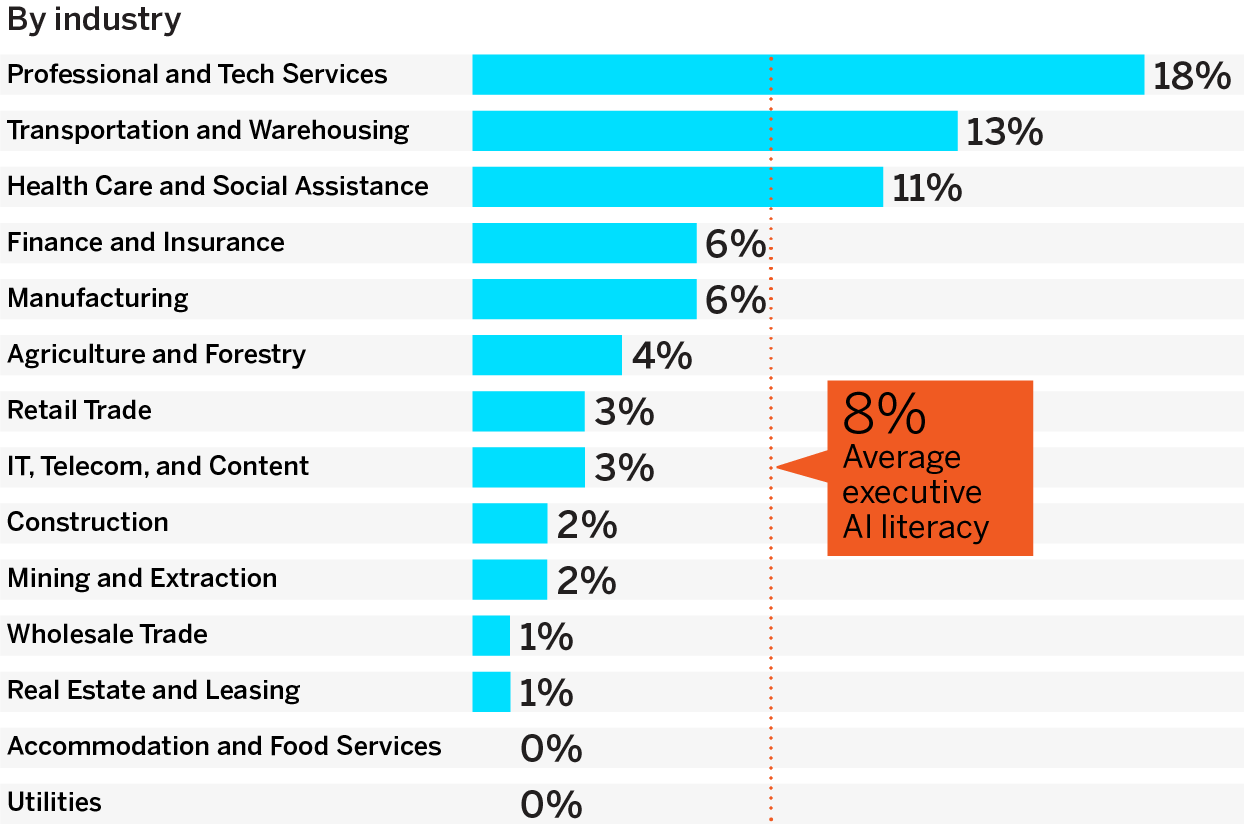Why Executives Can’t Get Comfortable With AI
AI will require continuous learning: Leaders need to embrace that uncomfortable reality and prioritize developing AI literacy.
News
- UAE Quietly Launches Its First Regulated Online Gaming Platform
- MBZUAI and AWS Join Hands for AI Research, Skills Development, and Startup Growth
- Nutanix and Pure Storage Launch Integrated Full-Stack Virtual Infrastructure
- UAE Leads the Region in Cryptocurrency Adoption, Ranks 5th Worldwide
- SpaceX’s IPO Plans and Tesla’s Pay Package Reveal the Economics of Elon Musk’s Ventures
- UAE Bets on AI to Transform Smallholder Farming With New Research Institute

Alice Mollon / Ikon Images
Executives need to have an understanding of information technology in order to derive business value from it and to productively interact with IT professionals. Nevertheless, IT experts have long lamented many executives’ limited knowledge of IT’s underlying functionality. In turn, many executives have (often unconsciously) declined to develop such IT literacy, preferring instead to focus their time and attention on domain and business matters.
However, recent evidence indicates that organizations that successfully unlock the strategic potential of artificial intelligence have executives and leaders who embody the opposite instinct: These leaders do have deeper knowledge of AI’s functionality.
Based on several recent and ongoing AI literacy studies, including analyses of 6,986 executives’ AI skills, 645 companies’ board structures, and experimental studies on human-AI collaboration, we suggest a new guiding theme for executives’ AI literacy: Make technology-related discomfort a habit.1 Here are three ways to develop and practice the habit of maintaining AI literacy.
1. Seek the Discomfort of Continual Learning About AI
In order to navigate the business and technological implications of AI, executives must accept the discomfort of always being on the cutting edge with their own understanding of AI. There are two reasons for this. One, AI is an elusive (and now overused) label that encompasses technology tools with very different kinds of properties. Organizational functions need different AI applications heavily tailored to their own data and workflows. For example, while AI chatbot applications based on large language models can make customer service agents more productive for sales and service support functions, decision tree algorithms enable apps that simplify predictive maintenance work for service operations.2 Knowing what distinguishes these different AI technologies will be crucial for business leaders who own and continually refine processes.
To meet expectations, executives don’t need to develop deep coding skills, but they do need a sound understanding of foundational AI principles.
Two, AI applications are changing at a furious rate, and the C-suite expects business leaders to keep up with the related transformation opportunities that open up. For example, less than half a year after the popularization of OpenAI’s ChatGPT, French communications company Bouygues Telecom deployed generative AI tools in its customer service process, challenging company executives to rapidly understand the technology and how it differed from earlier AI.3 To meet expectations, executives don’t need to develop deep coding skills, but they do need a sound understanding of foundational AI principles. In some cases, this will require executives to take in more technological knowledge than they would prefer.
How up to date are executives across functions in their understanding of what AI means, and what types of AI applications are relevant to their teams and the associated risks and benefits? Our analysis based on executives’ self-disclosed AI skills online in 2023 revealed that 8% of U.S. executives have substantial levels of conceptual knowledge concerning AI technologies such as deep learning.4 In the tech industry, the average AI literacy figure rises to 18%. (See data points for other industries in “Board-Level Executive AI Literacy Across Industries” below.) Not surprisingly, all assessed unicorn companies — privately held businesses with a valuation above $1 billion — have a higher AI literacy average, at 23%.
Board-Level Executive AI Literacy Across Industries
How many AI-literate executives are on your organization’s board? Results vary widely by industry right now, according to our recent research, but the overall average is just 8%.
Source: M. Pinski, T. Hofmann, and A. Benlian, “AI Literacy for the Top Management: An Upper Echelons Perspective on Corporate AI Orientation and Implementation Ability” and “Executive AI Literacy: A Text-Mining Approach to Understand Existing and Demanded AI Skills of Leaders in Unicorn Firms.”
The overall low literacy rate is a problem for today’s executives, who will face more and more processes or products that claim to be “powered by AI.” To appropriately judge them in a bigger context of the organization’s strategy and operations, and to even ask the right questions, executives require greater AI literacy.
How executives can embrace the discomfort of continual learning: Executives can implement technology-related discomfort into their routines. They should set up regular exchange sessions with AI experts in their organizations, attend educational technology programs tailored to executives, and allocate time to self-directed AI learning. The key: Leaders will need to repeatedly breach their comfort zones because AI involves a complex set of technologies. But comprehending which types exist, how they differ, and how they impact business is essential.
2. Drive Boardwide Learning
Some executives might not be interested in learning why AI is relevant to the organization and might perceive it as laborious. However, that labor is not optional anymore: AI is driving changes in processes across the enterprise so profound that they constitute significant strategic risks and opportunities within each executive’s areas of responsibility.
For this reason, part of promoting AI literacy for executives is recognizing that the whole board should embrace the discomfort. Leaders who already understand this need must advocate with their fellow board members that each person needs to become AI-literate.
One might expect people in a role like chief data officer to work with the CTO to develop an AI game plan. However, our analysis of 645 enterprises’ board structures showed that companies that are excelling in AI adoption have boards with an overall high level of AI literacy.5 A board with many AI-literate executives brings multiple perspectives on AI to the table, leading to higher scrutiny and strategically superior AI-related decisions.
Companies that are excelling in AI adoption have boards with an overall high level of AI literacy.
While, on average, only 3% of executives at S&P 500 companies are AI-literate today, some companies, like FedEx, already have a 29% AI literacy rate. AI is a team sport in general, but today’s companies have not fully appreciated that all executive team members need to be part of it.6
How executives can drive boardwide learning: Executives should strive to build a mini learning community. For example, they can commit to mutual development, make AI implications a part of each board member’s reporting requirements in board meetings, and invite AI experts to speak at board meetings. Collectively approaching AI not only fosters a culture of continuous learning but also ensures that AI is viewed as an integral part of the organization’s strategic vision. By embracing technology-related discomfort as a collective endeavor, executive teams and board members can leverage their diverse perspectives to identify potential pitfalls and opportunities presented by AI.
3. Prepare for Unexpected Effects
AI can cause unexpected, counterintuitive outcomes. For example, when studying human-AI collaborations, we found that humans can achieve higher performance by collaborating with AI, but this can also lower a person’s intention to use the AI — potentially due to perceived job threats.7 Despite the managerial urge to avoid the unexpected, executives should move forward on AI development but prepare as much as possible for unforeseen consequences.
For example, deploying generative AI solutions that hallucinate (meaning that they provide inaccurate information) can cause a company legal problems.8 When tools have a significant hallucination rate, it may discourage employees from using them and frustrate software engineers, who will need to frequently upskill their development knowledge as AI tools evolve. Due to such impacts on an organization, executives must continuously explore AI’s beneficial and nonbeneficial effects. Productive discomfort includes challenging your ability to anticipate AI’s consequences.
How executives can best prepare for AI’s unexpected effects: Learn from your peers: Study other organizations’ AI implementations. Famously, Amazon discontinued its AI-based recruiting tool in 2018 when it was found to exhibit bias against women. However, there are many AI failures to learn from — and for executives building AI literacy, time studying AI project successes and failures and how they could be emulated, mitigated, or avoided is time well invested.
The AI era demands a paradigm shift in executive thinking. No longer can leaders be content with a peripheral understanding of IT applications. By actively seeking out technology-related discomfort and transforming it into a relentless quest for AI literacy, executives can lead their organizations to success. The challenge is vast, but the potential rewards for those willing to embrace the discomfort are enormous.
References
1. Our extended analysis was based on two of our studies: M. Pinski, T. Hofmann, and A. Benlian, “AI Literacy for the Top Management: An Upper Echelons Perspective on Corporate AI Orientation and Implementation Ability,” Electronic Markets 34, no. 1 (2024): 1-23; and M. Pinski, T. Hofmann, and A. Benlian, “Executive AI Literacy: A Text-Mining Approach to Understand Existing and Demanded AI Skills of Leaders in Unicorn Firms,” in “Wirtschaftsinformatik 2023 Proceedings” (Paderborn, Germany: International Conference on Wirtschaftsinformatik, September 2023).
2. E. Brynjolfsson, D. Li, and L.R. Raymond, “Generative AI at Work,” working paper 31161, National Bureau of Economic Research, Cambridge, Massachusetts, November 2023; and S. Kaparthi and D. Bumblauskas, “Designing Predictive Maintenance Systems Using Decision Tree-Based Machine Learning Techniques,” International Journal of Quality & Reliability Management 37, no. 4 (2020): 659-686.
3. “AI for Everyone: Bouygues Telecom Achieves Rapid Innovation by Scaling AI on AWS IBM,” IBM, accessed April 2, 2024, www.ibm.com.
4. Pinski, Hofmann, and Benlian, “AI Literacy for the Top Management”; and Pinski, Hofmann, and Benlian, “Executive AI Literacy.”
5. Findings are valid for both established companies (S&P 500) as well as startups (unicorns).
6. M. Weber, M. Engert, N. Schaffer, et al., “Organizational Capabilities for AI Implementation — Coping With Inscrutability and Data Dependency in AI,” Information Systems Frontiers 25, no. 4 (August 2023): 1549-1569.
7. M. Pinski, M. Adam, and A. Benlian, “AI Knowledge: Improving AI Delegation Through Human Enablement,” in “CHI ’23: Proceedings of the CHI Conference on Human Factors in Computing Systems” (Hamburg, Germany: ACM Special Interest Group on Computer-Human Interaction, April 2023).
8. Pinski, Hofmann, and Benlian, “AI Literacy for the Top Management”; and Pinski, Hofmann, and Benlian, “Executive AI Literacy.”









